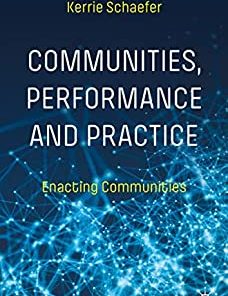Generalist Practice with Organizations and Communities 7th Edition by Karen Kirst Ashman, Grafton Hull 9798214342306
$50.00 Original price was: $50.00.$25.00Current price is: $25.00.
Generalist Practice with Organizations and Communities 7th Edition by Karen K. Kirst-Ashman, Grafton H. Hull, Jr – Ebook PDF Instant Download/DeliveryISBN: 9798214342306
Full download Generalist Practice with Organizations and Communities 7th Edition after payment.

Product details:
ISBN-13 : 9798214342306
Author : Karen K. Kirst-Ashman, Grafton H. Hull, Jr
EMPOWERMENT SERIES: GENERALIST PRACTICE WITH ORGANIZATIONS AND COMMUNITIES, 7th Edition is designed to help students better understand the dynamics of macro practice, and develop the competencies and practice behaviors required by the Council on Social Work Education’s (CSWE) latest Educational Policy and Accreditation Standards (EPAS). Authors Karen Kirst-Ashman and Grafton Hull are adept at creating interesting, realistic cases and practical examples that are skillfully woven into the main text. In clear and accessible writing, they emphasize the practical skills students will need to work effectively in the area of macro practice — providing leadership, working with supervisors, managing conflict, working with the media, using new technological advances, fundraising, grant writing, and managing stress. The text continues to emphasize the connections between working for change in organizations and communities and the skills used in other generalist practice courses.
Generalist Practice with Organizations and Communities 7th Table of contents:
Chapter 1. Introduction to Generalist Practice with Organizations and Communities
Generalist Practice Using the Generalist Intervention Model
Example: A Micro Approach
Example: A Mezzo Approach
Example: A Macro Approach
Generalist Practice: An Eclectic Knowledge Base
Human Behavior and the Social Environment (HBSE)
Social Welfare Policy and Policy Practice
Social Work Practice
Research
Values and Principles that Guide Generalist Practice
Sources that Guide Professional Values and Ethics in Practice
National Association of Social Workers (NASW) Code of Ethics
Awareness of Personal Values
Managing Ethical Dilemmas
Range of Practice Skills Used to Target Systems of Any Size
Differentiating Client Empowerment, Strengths, and Resiliency
Engaging Human Diversity
Recognizing the Influence of Differences
Advocating for Human Rights and Social, Economic, and Environmental Justice
Working Effectively Within an Organizational Structure
Professional Social Work Roles
Enabler
Mediator
Manager
Educator
Analyst/Evaluator
Broker
Facilitator
Initiator
Negotiator
Mobilizer
Advocate
Maintaining a Professional Identity and Roles
Using Critical Thinking Skills
A Formula for Critical Thinking
Avoiding Fallacies
A Final Note on Critical Thinking and Generalist Practice
Utilizing Research-Informed Practice
Using a Planned Change Process
Engagement
Assessment: Identifying Clients, Issues, and Collecting Information
Planning in Macro Practice
Implementing and Evaluating Macro Practice
Managing Termination in Macro Practice
Engaging in Follow-Up in Macro Practice
Specific Steps for Pursuing Planned Change in Macro Practice
Why Do You Need to Know About Practice with Organizations and Communities?
Understanding Macro Practice: Three Models of Community Organization
The Importance of Historical Perspectives
Chapter Summary
Competency Notes
Chapter 2. Stress and Time Management
The Relationship Between Stress and the General Adaptation Syndrome
General Adaptation Syndrome
Identifying Potential Stressors in Agency Settings
Perceptions of Stress
Stress-Management Strategies to Improve Practice Effectiveness
Managing your Stress
The Relationship Between Poor Time Management and Stress
How Poor Time Management Causes Stress
Styles of Dealing with Time
Use Time-Management Techniques to Improve Practice Effectiveness
Planning Your Time
Get Control of Your Own Behavior
Utilize Mechanisms for Eliminating Procrastination
Reasons for Procrastination
The Cons of Procrastination
Battling Procrastination
Chapter Summary
Competency Notes
Chapter 3. Using Micro Skills with Organizations and Communities
Using Empathy and Other Interpersonal Skills to Work Effectively Within Larger Systems
A Review of Basic Micro Skills
Verbal and Nonverbal Behavior
Eye Contact
Attentive Listening
Facial Expressions
Body Positioning
Multicultural Sensitivity and Nonverbal Behavior
Demonstrating Warmth, Empathy, and Genuineness
Warmth
Empathy
Genuineness
Utilize Nonverbal Communication and Empowerment with People Who Have Physical Disabilities
Interviewing and Communicating Effectively in Macro Contexts
Simple Encouragement
Sensitivity to Cultural Differences
Paraphrasing
Reflective Responding
Clarification
Interpretation
Providing Information
Emphasizing People’s Strengths
Summarization
Eliciting Information
The Use of “Why?”
Overlap of techniques
Personal Reflection and Professional Development
Using Assertiveness Skills in Macro Settings
Using Appropriate Assertiveness in the Macro Environment: Empowering Yourself and Others
Recognizing Nonassertive, Assertive, and Aggressive Communication
The Advantages of Assertiveness
Assertiveness Training
A Final Note on Assertiveness Training
Chapter Summary
Competency Notes
Chapter 4. Group Skills for Organizational and Community Change
Understanding Conflict
Employ Leadership Skills in Social Work Services
Identifying Targets for Change
Inspiring Others
Using Assertiveness
Employing Communication Skills
Leading by Example
Bringing New Perspectives
Using Self
Understanding the Media
Providing Leadership Skills in Task Groups
Managing Conflict
Distinguishing Leadership and Administration
Employing Leadership and Power
Networking to Analyze, Formulate, and Advocate for Policies and Practices That Advance Social Well-Being
Recognizing the Importance of Networking
Networks: Mutual Aid
Types of Networks
Problems with Networks
Worker Roles in Networking
Teamwork and Collaboration with Colleagues and Clients
Characteristics of Effective Teams
Planning and Conducting Meetings
Plan Ahead
Clarify Purpose and Establish Objectives
Select Participants
Select a Time and Place
Prepare an Agenda
Start Meetings on Time
State Ending Time at the Start
Keep the Group on Target
End the Meeting on Time
Plan for Follow-Up Meetings
Parliamentary Procedure
Advantages and Disadvantages of Parliamentary Procedure
Basic Parliamentary Concepts
Amendments
Voting Rights
Conflict Management
Advocating and Conflict
Recognizing Types of Conflict
The Pros of Conflict
The Cons of Conflict
Personal Styles for Addressing Conflict
Procedures for Conflict Resolution
Step 1: The Confrontation
Step 2: Establish Common Ground
Step 3: Emphasize the Importance of Communication
Step 4: Emphasize Your Willingness to Cooperate
Step 5: Empathize with Your Opponent’s Perspective
Step 6: Evaluate Motivations to Address the Conflict
Step 7: Come to Some Mutually Satisfactory Agreement
Advanced Conflict Management: Guidelines and Strategies
Focusing on Power
Generating Conflict
Conflict Management by Covert Means
More Specific Tactics
Conflict Management by Emergent Agreement
Conflict Management by Coactive Disputation
Conflict Management by Negotiated Agreement
Conflict Management by Indirect Means or Procedural Measures
Conflict Management by Exercise of Authority/Power
Chapter Summary
Competency Notes
Chapter 5. Understanding Organizations
Defining Organizations, Social Services, and Social Agencies
Organizations
Social Services
Social Agencies
The Macro Context of Organizations
The Shifting Macro Environment and Shrinking Resources
Legitimation
Client Sources
Theoretical Approaches to Understanding Organizations
Classical Organizational Theories
Neoclassical Organizational Theories
Human Relations Theories
Feminist Theories and Organizations
The Cultural Perspective
Political-Economy Theory
The Institutional Perspective
Contingency Theory
Culture-Quality Theories
Systems Theories
Which Organizational Theory is Best?
Assessing Organizations and Agencies from a Systems Perspective
Appraising Organizations from a Systems Perspective
Resource Input
Process Through Organizational Technology
Output
Outcomes
Defining the Nature of Organizations
Agency Settings
Organizational Mission Statements
Defining Organizational Goals
Organizational Culture
Organizational Structure
Power and Politics in Organizations
Ethical Behavior Within Organizational Contexts
Centralized Versus Decentralized Organizations
Comparing Methods of Management
Working in a Traditional Bureaucracy
Social Work Values and Organizational Values
How to Survive in a Bureaucracy
Management and Worker Empowerment
Constructing a Culture Of Caring
The Learning Organization
Teamwork and Team Empowerment
Managing Diversity
Comparing Specific Management Approaches
Total Quality Management
Empower Macro Client Systems to Improve Social, Economic, and Environmental Justice
Continuous Improvement
Servant Leadership
Common Problems Encountered in Organizations
Impersonal Behavior
Lack of Rewards and Recognition
Agency Policy and Worker Discretion
Traditions and Unwritten Rules
Chapter Summary
Competency Notes
Chapter 6. Decision Making for Organizational Change
Changing Organizations through Agency Policies, Projects, and Programs
Undertaking Specific Projects
Initiating and Developing Programs
Changing Agency Policies
Informal Agency Policies
Beginning the Change Process
Assess the Potential for Organizational Change
Step 1: Problem Identification—Identify Problems to Address
Substep 1: Seriously Evaluate the Potential for Macro-Level Intervention
Substep 2: Define and Prioritize Problems
Substep 3: Translate Problems into Needs
Substep 4: Determine which Need or Needs to Address
Step 2: Reality Check—Review Your Macro and Personal Reality
Substep 1: Evaluate Variables Working for or against You in the Macro-Change Process
Substep 2: Review Your Personal Reality—Strengths and Weaknesses that May Act for or against Successful Change Efforts
Step 3: Establish Primary Goals
Step 4: People Resources—Identify Relevant People of Influence
Rationales for Internal Advocacy
Step 5: Assess Potential Costs and Benefits to Clients and Agency
Step 6: Assess Personal Strengths and Weaknesses in the Context of Organizational Change
Could I Lose My Job?
Will My Career Path Be Affected?
Will I Strain Interpersonal Relationships at Work?
A Strengths Perspective on Risk
Appraise the Potential for Internal Advocacy to Improve Client Access to Services
Step 7: Evaluate the Potential Success of a Macro-Change Process
Substep 1: Review the Process and Weigh the Pros and Cons of Proceeding
Substep 2: Identify Possible Macro Approaches to Use, Estimate their Effectiveness, and Select the Most Appropriate One
Looking Ahead
Chapter Summary
Competency Notes
Chapter 7. Implementing Organizational Change: Agency Policy, Projects, and Programs
Conceptualize the Macro-Practice Environment, Client, Change Agent, Target, and Action Systems
The Macro Client System
The Change Agent System
The Target System
The Action System
Change Agency Policy to Advance Social Well-Being
Understanding Agency Policy
Types of Agency Policy Changes
Initiate and Implement a Program
Articulating the Planned Change Process and Organizational Change
Utilize a Process for Implementing Macro-System Change
Identify an Innovative Idea
Muster Support and Formulate an Action System
Formulate an Action System
Identify Assets
Communicate Effectively Utilizing Memos and E-mails
Develop Goals, Objectives, and Action Steps to Attain Them
Goals
Objectives
Action Steps
Implement the Plan
Describe How the Changes Will Affect Services
Anticipate Target System Receptiveness
Emphasize Communications
Utilize a Planning Tool to Achieve Organizational Change
PERT Charts Illustrate Objectives and Action Steps
PERT Charts Portray Specific Tasks
PERT Charts Depict Task Sequence
PERT Charts and Necessary Resources
PERT Charts Establish a Time Frame
Advantages of PERT Charts
Neutralize Opposition to a Planned Change Effort
Communicating with Decision Makers
Logical Administrative Reactions
Phases of Resistance
Collaborative and Adversarial Strategies
Collaboration and Persuasion
Evaluate Outcomes in Macro Practice
Monitor Daily Activities and Evaluate Impact
Use the Macro-Change Process to Establish a Culturally Competent, Empowering Organization
Defining Cultural Competence
Assessing Cultural Competency
Recommendations for Attaining Cultural Competence
Program Development: A Case Example
The Shape Program
Start with An Innovative Idea
Muster Support
Identify Assets
Specify Goals, Objectives, and Action Steps to Attain Them
Implement the Plan
Neutralize Opposition
Evaluate Progress
Looking Ahead
Chapter Summary
Competency Notes
Chapter 8. Understanding Neighborhoods and Communities
Professional Roles of Social Workers in Neighborhoods and Communities
Theoretical Frameworks for Understanding Communities and Neighborhoods
Spatial Communities
Social Communities
Political Communities
Communities and Neighborhoods
Functions of Communities
Types of Spatial Communities
Systems Perspective for Viewing the Community as an Ecological and Social System
The Community as an Ecological and Social System
Ecological Perspective
Social Systems Perspective
Social Structural Perspective
Human Behavior Perspective
Additional Perspectives on the Community
Key Concepts to Discover and Assess Changes in Neighborhoods and Communities
Competition
Centralization
Concentration
Invasion
Gentrification
Succession
Concepts Characterize Real Life
Utilize Community Resource Systems with Neighborhoods and Communities
Demographic Development of Communities
Urbanization and Suburbanization
Rural Communities
Where is the Best Place to Live?
Community Factors Affecting Human Rights and Social, Economic, and Environmental Justice: Social Stratification, Economic and Political Systems, and Power
Social Stratification
Community Economic Systems
Community Political Systems
Formal Organizations and Informal Political Processes
Power in the Community
Neighborhoods as Helping Networks and Resources
Functions of Neighborhoods
Types of Neighborhoods
Neighborhoods as Helping Networks
Neighborhood Organizations
Community and Neighborhood Resources
The Ability of Communities and Neighborhoods to Advance Social Well-Being and Respond to Residents’ Needs
Community Needs Assessments
Purposes of a Community Assessment
Steps in Conducting a Community Assessment
Chapter Summary
Competency Notes
Chapter 9. Macro Practice in Communities
Advance Social, Economic, and Environmental Justice in Communities
Philosophical Perspective on Macro Practice: Pursuit of Social, Economic, and Environmental Justice
Utilize Theoretical Frameworks and Strategies for Empowering Communities
Perspectives on the Community
Approaches to Community Change
Beginning the Change Process
Engage and Assess the Potential for Community Change
Intervene and Evaluate Change in a Community
Start with an Innovative Idea
Muster Support and Formulate an Action System
Identify Assets
Specify Goals, Objectives, and Action Steps
Implement the Plan
Neutralize Opposition
Evaluate Progress
Chapter Summary
Competency Notes
Chapter 10. Evaluating Macro Practice
Program Evaluation Research Informs Practice
The Context of Program Evaluation
Purposes of Program Evaluation: A Summary
A Review of Key Concepts in Evaluation
Control Group
Experimental Group
Dependent Variable
Independent Variable
Sampling
Experimental Design
Quasi-Experimental Designs
Baseline
Measures of Central Tendency
Standard Deviation
Reliability
Validity
Descriptive Statistics
Inferential Statistics
Outcome
Outcome Measures
Statistical Significance
Chi-Square Test
Correlation Test
Problems and Barriers in Program Evaluation
Failure to Plan for Evaluation
Lack of Program Stability
Relationships Between Evaluators and Practitioners
Evaluation Results are Unclear
Evaluation Results are Not Accepted
When Evaluation is Not Worth the Effort
Models of Evaluation
Formative (or Monitoring) Evaluations
Summative (or Impact) Evaluations
Effectiveness and Efficiency Evaluations
Evaluation Approaches
Quantitative Methods
Qualitative Methods
One-Group Posttest Designs
Pretest/Posttest Designs
Client Satisfaction Surveys
Goal Attainment Scaling
Target Problem Scaling
Case Studies
Group Comparisons
Quality Assurance Reviews
Summary of Evaluation Designs
Stages and Steps in Evaluation
Stage 1: Conceptualization and Goal Setting
Stage 2: Measurement
Stage 3: Sampling
Stage 4: Design
Stage 5: Data Gathering
Stage 6: Data Analysis
Stage 7: Data Presentation
Communicate Evaluation Data
Part 1: Introduction
Part 2: Literature Review
Part 3: Methodology
Part 4: Results
Part 5: Discussion
Part 6: References and Appendices
Summary of Data Presentation
Uphold Ethics and Values in Evaluation
Chapter Summary
Competency Notes
Chapter 11. Advocacy and Social Action with Populations at Risk
Key Concepts Involved with Macro Practice
Advocacy
Social Action
Empowerment
Populations at Risk
Risk Factors for Social, Economic, and Environmental Injustice
Factors Contributing to Putting Populations at Risk
Examples of Populations at Risk
Advocacy, Social Action, and Empowerment Activities
Advocacy
The Values and Limitations of Advocacy
Agency Commitment to Advocacy
Opportunities for Macro-Level Advocacy
Principles of Macro-Level Advocacy
Guidelines for Macro-Level Advocacy
Advocacy Tactics
Grassroots and Grasstop Advocacy and Organizing
Locating Grasstop Supporters
Identity the Help You Need
Recruitment Strategies
The Use, Value, and Limitations of Advocacy
Theoretical and Conceptual Models of Social Action
Alinsky’s Social Action Approach
Critique Macro Practice Using Professional Knowledge, Skills, and Values
Legal Action
Participatory Action Research: Practice Informs Research, and Research Informs Practice
Social Worker Roles in Par
Empowerment
Recognizing Strengths
Legislative Advocacy and Political Activity Advance Social, Economic, and Environmental Justice
Factors Affecting Legislative Advocacy
Steps in Legislative Advocacy
Other Political Activities
Chapter Summary
Competency Notes
Chapter 12. Ethics and Ethical Dilemmas in Practice with Organizations and Communities
The NASW Code of Ethics in Organizational and Community Practice
The NASW Code of Ethics
Social Workers’ Ethical Responsibilities to Clients
Social Workers’ Ethical Responsibilities to Colleagues
Social Workers’ Ethical Responsibilities in Practice Settings
Social Workers’ Ethical Responsibilities as Professionals
Social Workers’ Ethical Responsibility to the Social Work Profession
Social Workers’ Ethical Responsibilities to the Broader Society
The Role of Ethical Boundaries when Addressing Spirituality
Demonstrate Familiarity with International Social Work Ethical Principles
Human Rights and Social Justice
What Can You Do?
Manage Personal Values and Use Professional Values to Guide Practice
Types of Ethical Issues Confronting Agency Practitioners
Ethical Absolutism versus Ethical Relativism
Ethical Reasoning Strategies to Make Principled Decisions
Facing an Ethical Dilemma: Decision-Making Steps
Ranking Ethical Principles
Reamer’s Guide to Ethical Decision Making
Dolgoff, Harrington, and Loewenberg’s, “Ethical Principles Screen”
Ethical Dilemmas in Macro Contexts
Distribution of Limited Resources
Community Support (or Lack Thereof) for Service Provision
Relationships with Colleagues
Ambiguity Affects Ethical Decision Making
Conforming to Agency Policy
Breaching Confidentiality in a Macro Context
Cultural Differences Influence Ethical Practice
Insurance Company Requirements
Other Potential Ethical Dilemmas
Co-Optation versus Cooperation
Conflict of Interest
Potential Harm to Participants
Stigmatization Tactics
Furthering Ethical Practice in Agency Settings
Chapter Summary
Competency Notes
Chapter 13. Using Supervision
The Functions of Supervision
Administrative Functions of Supervisors
Educational Functions of Supervisors
Support Functions of Supervisors
Using Supervision, Improving Supervisory Relationships, and Enhancing the Communication Process
Use Communication Skills with Your Supervisor
Keep Your Records Up to Date
Plan Your Supervisory Agenda Ahead of Time
Put Yourself in Your Supervisor’s Shoes
Display Openness to Learning and to Improving Yourself
Demonstrate a Liking for Your Work
Follow the Rules
Think Beyond Tomorrow
Work Cooperatively with Other Staff
Do More Than Expected
Give Your Supervisor Feedback
Forewarn Your Supervisor About Problematic Situations
Learn Your Supervisor’s Evaluation System
Manage Potential Problems in Supervision
Supervisor-Supervisee Misunderstandings
Supervisors Who Take Credit for Your Achievements
Supervisory Incompetence
Laziness
Problems with Delegation
Inability to Deal with Conflict
A Final Note
Chapter Summary
Competency Notes
Chapter 14. Developing and Managing Agency Resources
Working with the Media to Advance Social Well-Being and Social, Economic, and Environmental Justice
The Nature and Role of Social Media
General Guidelines for Working with the Media
Utilize Professional Communication Strategies with the Media
Media Interviews
Letters to the Editor and Editorials
Technology for Managing Resources, Service Delivery, and Evaluating Agency Effectiveness
Understanding Computer Hardware
Understanding the Software
Agency Software Usage
General Observations about Computers
Other Macro Uses of Technology
Fund-Raising
Sources of Funds
Differentiating Grants from Contracts
Grants and Contracts: Who’s Got the Money?
Government Grants
Foundation Grants
Business and Corporate Grants
Key Steps in Securing Grants
Pre-Application Phase
Application Phase
Writing a Grant Proposal
Kinds of Grants and Contract Proposals
Post-Application Phase
Chapter Summary
Competency Notes
People also search for Generalist Practice with Organizations and Communities 7th:
generalist practice with organizations and communities pdf free
generalist practice with organizations and communities exam
generalist practice with organizations and communities citation
generalist practice with organizations and communities pdf
generalist practice with organizations and communities 7th edition
Tags:
Generalist Practice,Organizations,Communities,Karen Kirst Ashman,Grafton Hull
You may also like…
Social Science
Business & Economics - Responsibility and Business Ethics
Philosophy and Business Ethics: Organizations, CSR and Moral Practice Guglielmo Faldetta
Business & Economics - Human Resources
Business & Economics - Project Management
Fiction
Arts - Performing Arts
Communities, Performance and Practice: Enacting Communities Kerrie 3030957578 9783030957575












